You might have seen blue glass plates or cups lying around in your Grandmother’s attic or at a garage sale and wondered if they are valuable pieces. This type of glassware is called depression glass, and it is a popular antique with a rich history.
Blue depression glass is typically worth about $10-$70 for an individual piece—larger items or full sets can be worth over $200. Certain designs, brands, and colors of glass are more desirable than others. Blue Mayfair pieces, for example, can be worth several hundred dollars.
It can be hard to tell whether an antique has much value or not, but knowing more about depression glassware can help one pick out a rare, priceless gem of blue glass.

Blue Depression Glass Worth
Blue depression glass is typically worth about $10-$70 for an individual piece, such as a single plate or cup, but larger items (like a pitcher) or full sets can be worth over $200. However, if your piece is a reproduction, it will be rendered practically worthless. Authentic pieces will have several signs that prove authenticity, including:
- Noticable seams in the glass
- Scratching from utensils
- Greasy rather than squeaky feel
- Feels lighter and less sturdy
- Lines along the bottom from production
Another major factor that can affect the worth of your antique is the condition. It is common to find chips and cracks in old glassware, so pieces that have maintained mint conditions will be worth more. Collectors also steer clear of “sick” glass, which is glass that has been clouded by being washed in a dishwasher.
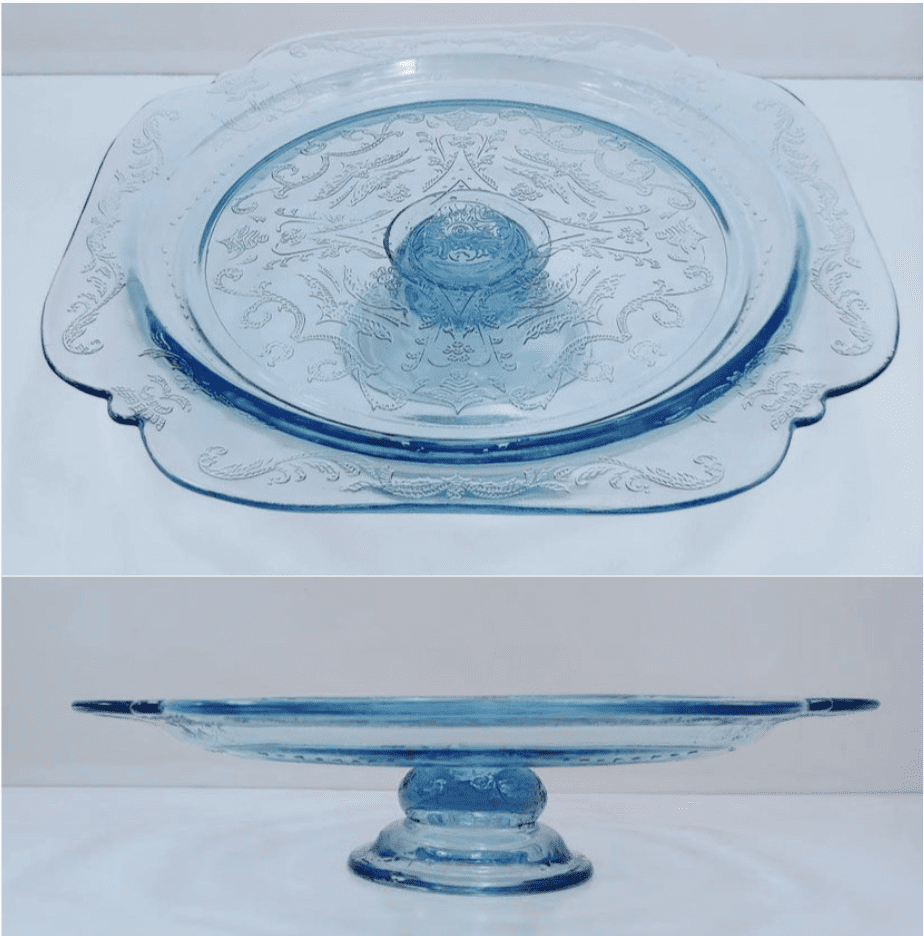
Today, depression glass is a highly collectible item. Different collectors might favor different brands, specific items, or colors. It is popular to seek out more unusual serving dishes like unique platters, coffee servers, butter dishes, or cake plates. One unique item is furniture coasters that were made to keep tables and chairs from marking carpets or floors. Some serving dishes were designed in a shape like a violin or a heart. What draws many depression glass collectors’ attention is the uniqueness of a piece.
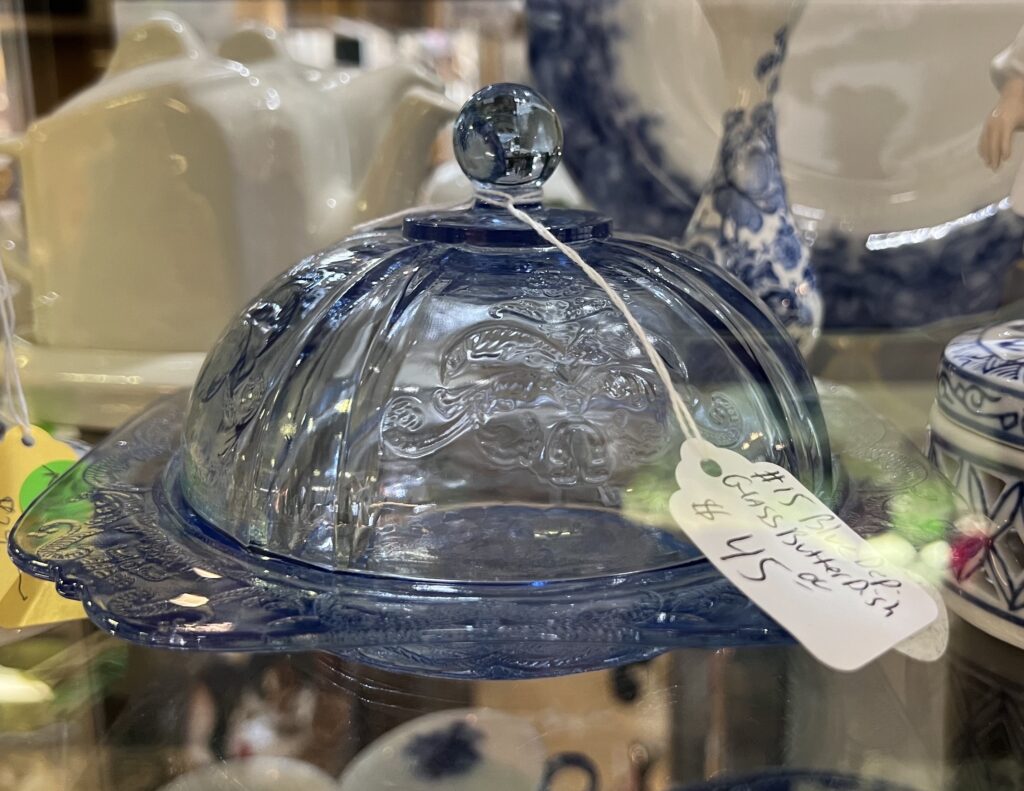
Some collectors are interested in building up a matching collection, others like to mix and match patterns together. Many collectors continue to use the pieces they purchase, while many keep them on display in their homes, preserving their life for many years to come.
Who Made Blue Depression Glass?
Depression glass was manufactured between the mid 1920s and early 1940s and was meant to be affordable and produced in mass quantities. Previously, glassware had always been hand-cut and therefore only affordable to the wealthy. Not only is it quite pretty, but was a symbol of hope during Great Depression, as the common family could finally afford to adorn their home with glassware.
There were many different companies who manufactured these notable blue pieces, but some of the most well-known include:
- Hazel Atlas Glass Company
- Hocking Glass Company
- Lancaster Glass Company
- U.S. Glass Company
- L. E. Smith Glass Company
- Federal Glass Company
- Indiana Glass Company
- MacBeth-Evans Glass Company
- Jeanette Glass Company
- Imperial Glass Company
While many companies made depression glass in the blue color, Hazel Atlas Glass Company sold some of the most popular patterns in what they called “Ritz Blue.
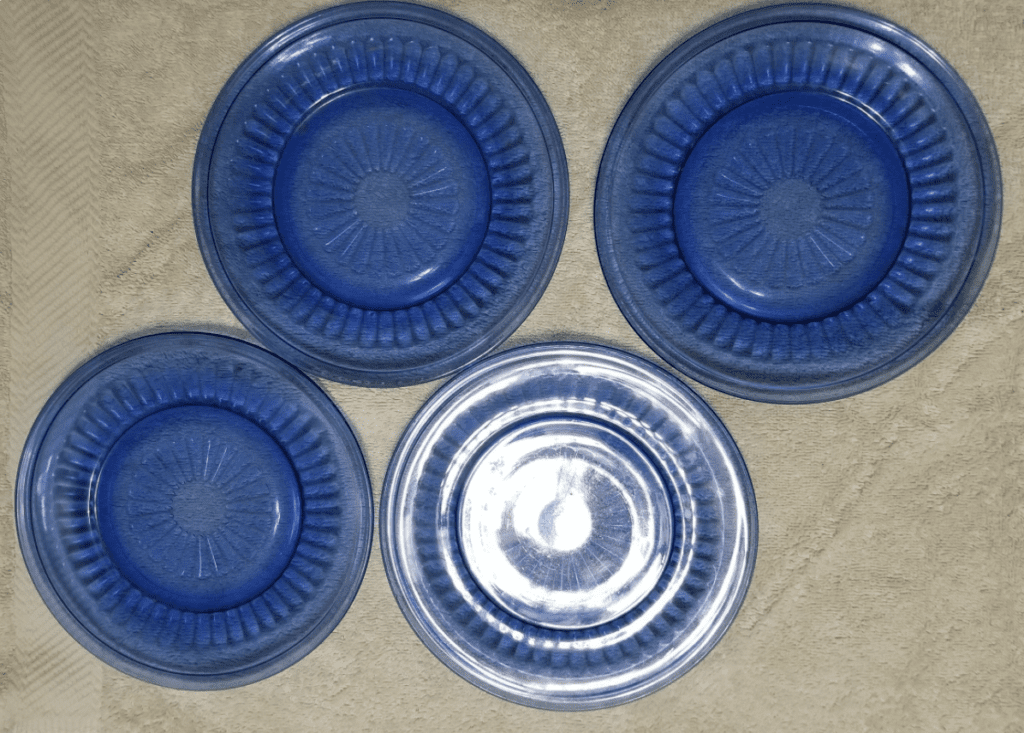
What Is Cobalt Blue Depression Glass?
Cobalt blue glass is a deep blue color that comes from cobalt oxide that is mixed into the glass mixture. Copper and nickel contain small amounts of cobalt, which is the metal that produces this striking color. After creating this royal blue color in the glass, the glass would then be crushed up into a powder known as “smalt,” which would be used to color the larger batch of glass.
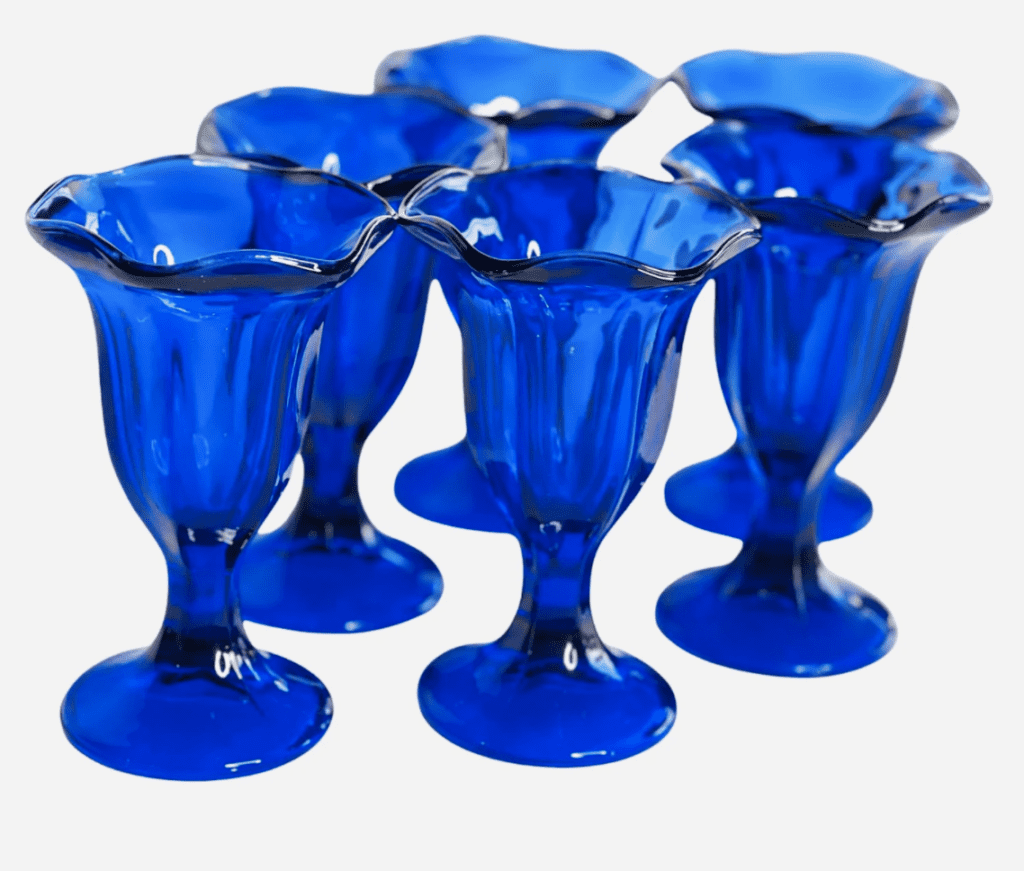
Both Hocking Glass Co. and Hazel Atlas Glass Co. produced pieces in cobalt blue, which included Shirley Temple pieces and the popular Modernton and Royal Lace designs.
The earliest known cobalt blue glass piece came way before the era of the Great Depression. A small lump was discovered by archeologists in ancient Mesopotamia dating as far back as 2000 BC. About 500 years later, Egyptians began using it in pottery.
The Chinese were also fans of the striking color, as they used cobalt blue smalt glazes in their porcelain for the Chinese Dynasty. Later, the popularity of this look arrived in Europe as well.

What Is the Old Blue Glass Called?
The old blue glass is called depression glass. This look is easily manufactured and reproduced, so there are many different types of glassware, like blown or decorative glassware, that may have a similar coloring to the blue depression glass, so just because a piece of glassware is old, does not necessarily mean that it is bonified depression glass.
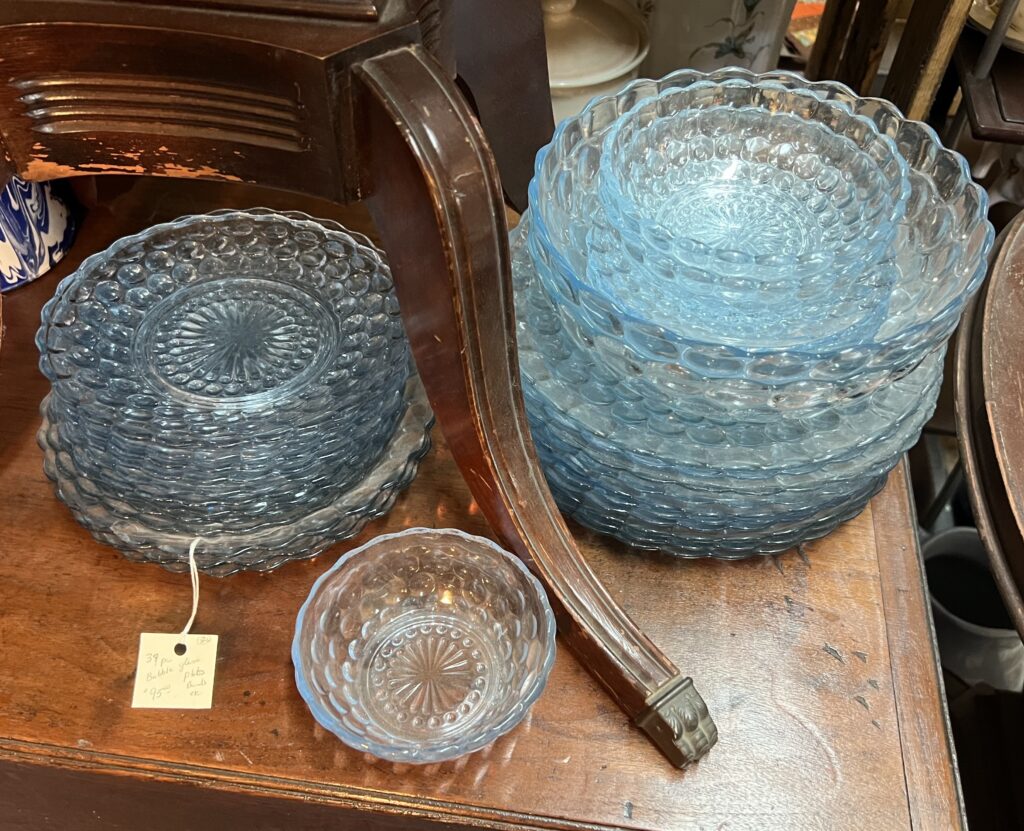
One major giveaway to depression glass is the purpose of the piece. Depression glass was meant to look beautiful and be functional at the same time. Consumers of these glassware sets were almost always people who planned to use them in their home for eating and serving meals, so it is rare to find depression glass that is purely decorative—for example, a vase or an abstract art piece.
What Is Vintage Blue Glass Called?
The vintage blue glass is known as depression glass or cobalt glass. Sometimes depression glass is confused with pressed glass or Carnival glass. Pressed glass refers only to a method that was used to decorate bowls or plates with a pattern. So some depression glass might also be pressed glass, but not all depression glass is pressed.
Carnival glass is multicolored, iridescent glassware that had very intricate patterns on it. Carnival glass was produced earlier in the 20th century before depression glass and was sold as individual pieces, unlike depression glass which almost always sold in sets.
Interestingly, some food manufacturers wanted to boost their sales, so they would often include a piece of glassware in food boxes. When purchasing a box of oats, flour, or laundry detergent it, wouldn’t be rare to open it up and find a glass mug perfectly padded within the product. Some movie theatres or mechanic shops even joined in with this popular trend, offering depression glass pieces as a premium to their customers.
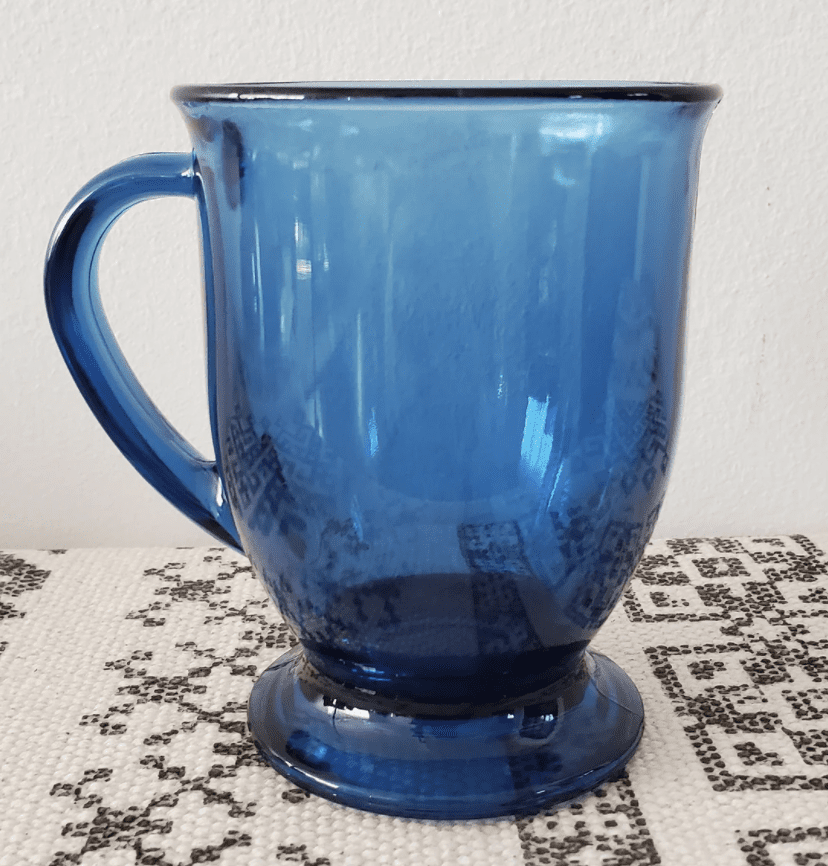
When Was Cobalt Blue Glass Popular?
Cobalt blue glass wasn’t first invented during the Great Depression. It has actually been considered a treasure since ancient times. Researchers have discovered ancient Egyptian and Mesopotamian pieces made of or containing cobalt blue glass.
When industrialization made the production of this glass easier in the 1800s, cobalt blue glass became more commonplace in the average household. It was made into utilitarian bottles that held tinctures or medicines.
The Hazel Atlas Glass Co. again made the glass more desirable when they produced several glassware sets in the color. The most popular colors during the production era were yellow, amber, green, and blue.
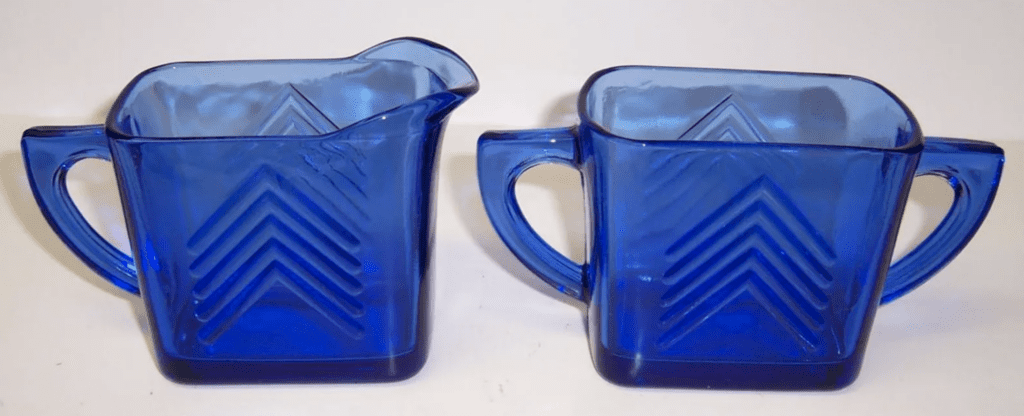
Today, pink depression glass is the most valuable, followed by blue, then green. Some colors were produced in small batches like lavender and tangerine. The rarity of the color typically increases the value of the piece.
Does Blue Depression Glass Glow
Originally the green depression glass and Vaseline glass contained small amounts of uranium oxide which causes the glass to glow when placed under a UV light. Because the blue glass doesn’t contain any uranium, it does not glow.
The uranium oxide was added to the glass to give it that fluorescent green or yellow color. Each company had a different name for this unique color like jasmine, mustard, golden gree, citron, and Florentine.
Some say that it is dangerous to eat from these dishes due to the radioactive nature of uranium, but the amount that seeps through the glass is so insignificant, that there isn’t any harm in eating from these pieces.

